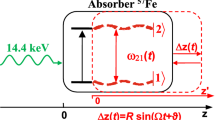In this paper, the method of transforming the Mössbauer gamma radiation into a train of ultrashort pulses in a resonant nuclear absorber, which harmonically oscillates as a whole along the direction of radiation propagation [1], was generalized to the case of multifrequency absorber oscillations. Based on the example of the Mössbauer absorber 57Fe and the radioactive Mössbauer source of 14.4 keV photons 57Co, it is shown that under optimal conditions, adding new harmonics of the fundamental frequency to the law of absorber motion makes it possible to reduce the duration and increase the intensity of the generated pulses while maintaining their repetition period. An optimal law of absorber motion leading to the formation of the shortest and most intense pulses is derived. It corresponds to periodic fast displacements of the absorber relative to the source by the wavelength of resonant radiation. In this case, the duration of each individual pulse of the output radiation is determined by the duration of the constructive interference that appears and disappears with a rapid change in the relative phase between the incident field and the field coherently forward-scattered by the nuclei of the moving absorber due to the Doppler effect. The possibility of transforming quasi-monochromatic radiation into a single intense short pulse, the duration and instant of the formation of which are determined by the duration and instant of the onset of the absorber displacement, is shown.
Similar content being viewed by others
References
F.Vagizov, V. Antonov, Y. V. Radeonychev, et al., Nature, 508, 80–83 (2014). https://doi.org/10.1038/nature13018
F.Döring, A. L.Robisch, C. Eberl, et al., Opt. Express, 21, No. 16, 19311–19323 (2013). https://doi.org/10.1364/OE.21.019311
S. Shwartz, R.N.Coffee, J. M. Feldkamp, et al., Phys. Rev. Lett., 109, 013602 (2012). https://doi.org/10.1103/PhysRevLett.109.013602
R.Röhlsberger, H.-C.Wille, K. Schlage, and B. Sahoo, Nature, 482, 199–203 (2012). https://doi.org/10.1038/nature10741
R.Röhlsberger, K. Schlage, B. Sahoo, et al., Science, 328, 1248–1251 (2010). https://doi.org/10.1126/science.1187770
K.P. Heeg, H.-C. Wille, K. Schlage, et al., Phys. Rev. Lett., 111, 073601 (2013). https://doi.org/10.1103/PhysRevLett.111.073601
Y. V.Radeonychev, I.R. Khairulin, F.G.Vagizov, et al., Phys. Rev. Lett., 124, 163602 (2020). https://doi.org/10.1103/PhysRevLett.124.163602
K.P. Heeg, C.Ott, D. Schumacher, et al., Phys. Rev. Lett., 114, 207401 (2015). https://doi.org/10.1103/PhysRevLett.114.207401
K.P. Heeg, J.Haber, D. Schumacher, et al., Phys. Rev. Lett., 114, 203601 (2015). https://doi.org/10.1103/PhysRevLett.114.203601
J.Haber, K. S. Schulze, K. Schlage, et al., Nature Photon., 10, 445–449 (2016). https://doi.org/10.1038/nphoton.2016.77
R. N. Shakhmuratov, F. G.Vagizov, V. A. Antonov, et al., Phys. Rev. A, 92, 023836 (2015). https://doi.org/10.1103/PhysRevA.92.023836
V. A. Antonov, Y. V. Radeonychev, and O.Kocharovskaya, Phys. Rev. A, 92, 023841 (2015). https://doi.org/10.1103/PhysRevA.92.023841
I.R. Khairulin, V.A.Antonov, Y.V.Radeonychev, and O.Kocharovskaya, Phys. Rev. A, 98, 043860 (2018). https://doi.org/10.1103/PhysRevA.98.043860
Y. V. Radeonychev, V. A. Antonov, F. G.Vagizov, et al., Phys. Rev. A, 92, 043808 (2015). https://doi.org/10.1103/PhysRevA.92.043808
F. J. Lynch, R. E.Holland, and M.Hamermesh, Phys. Rev., 120, 513 (1960). https://doi.org/10.1103/PhysRev.120.513
I.R. Khairulin, V.A.Antonov, Y.V.Radeonychev, and O. A.Kocharovskaya, J. Phys. B: At. Mol. Opt. Phys., 51, 235601 (2018). https://doi.org/10.1088/1361-6455/aaeb84
R. N. Shakhmuratov, Phys. Rev. A, 100, 043823 (2019). 0.1103/PhysRevA.100.043823
E. Ikonen, P.Helist¨o, T.Katila, and K.Riski, Phys. Rev. A, 32, 2298 (1985). https://doi.org/10.1103/PhysRevA.32.2298
X. Zhang, W.-T. Liao, A. Kalachev, et al., Phys. Rev. Lett., 123, 250504 (2019). https://doi.org/10.1103/PhysRevLett.123.250504
Author information
Authors and Affiliations
Corresponding author
Additional information
Translated from Izvestiya Vysshikh Uchebnykh Zavedenii, Radiofizika, Vol. 65, No. 4, pp. 269–286, April 2022. Russian DOI: https://doi.org/10.52452/00213462_2022_65_04_269
Rights and permissions
Springer Nature or its licensor (e.g. a society or other partner) holds exclusive rights to this article under a publishing agreement with the author(s) or other rightsholder(s); author self-archiving of the accepted manuscript version of this article is solely governed by the terms of such publishing agreement and applicable law.
About this article
Cite this article
Khairulin, I.R., Radeonychev, Y.V., Antonov, V.A. et al. Optimal Motion Law of a Resonant Nuclear Absorber for the Formation of Short Pulses of Mössbauer Radiation. Radiophys Quantum El 65, 247–262 (2022). https://doi.org/10.1007/s11141-023-10209-3
Received:
Accepted:
Published:
Issue Date:
DOI: https://doi.org/10.1007/s11141-023-10209-3



